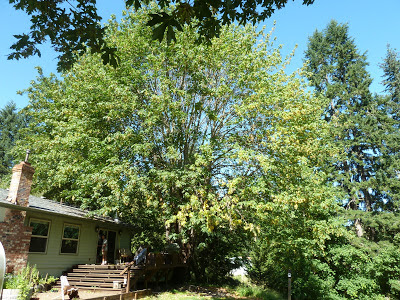Who needs daylight savings time to tell them when to get up or that it’s too light out to rest your body horizontally? The heat is on, and when you’re contending with the sun, the better you get done.
In our years of networking one avenue we ventured was trying to engage city folk into a relationship with country folk, or people living on acreage. City lawns will not feed city blocks, not by themselves. Take a look around at your neighbors, neighbors kids and figure an average daily calorie count by what you see, then think about the food that it will take to fulfill that calorie intake.
Even though we know as hunger goes up, calorie intake will go down, much like what happened in Cuba (Power of Community). We also know that it will take more physical energy to grow food without the resources we have available to us today, causing us to look more like we should or I’ll just say healthier.
So where does one start when planning a garden in the midst of collapse? Though we don’t consider to be experts on the subject, we do have a fair amount of knowledge that we’ve gained growing food for a combined 20+ years of our married life, and most recently 10+ here in the PNW. We’re happy to share what we’ve learned as we know time in running out for those who are just starting to contemplate the idea of sustaining themselves sufficiently.
Trading these secrets will become more important than wire tapping as we know the real terrorists live in our gardens destroying our crops, hiding in their underground tunnels where the green revolution has just begun for them.
In our neck of the woods, we’ve had to use an arsenal of weapons such as castor oil, wicked killing traps and golf clubs. The game is called “whack a mole” and for every one we catch, 2 more escape so the war on terror continues an food takes the place of oil and one has to wonder how many miles to the gallon one will get?
Trying to work with pests sharing a percentage of food (one year it was 40#’s of potatoes out of 150#’s) with them will only become more problematic when we’re producing less due to extreme and erratic weather patterns as we’re already witnessing.
This past week our area was under an Excessive Heat Warning and for several days it was 90+ degrees. Our boysenberries and marionberries bloomed earlier than ever and were looking very healthy.
 |
| Marionberries from the garden 2013 |
 |
| Dying Big Leaf Maple outside our backdoor 2013 |
So much is affected by weather and yet we’ve heard so many say, “we’ll soon get rain, we always do”, or “this heat can’t last forever”. Both of these statements may be true but depending on when we get rain/heat or not, can test anyone’s ability to grow a good enough crop to either collect seed from, supply our own food, or generate an income.
With the yearly weather fluctuations we have to thank our wall street criminals that taught us to diversify, diversify, and diversify. Unlike monocropping we’ve tried to create a living system that feeds more than just us.
The bees are out in numbers now and we step lightly on the clover planted between the beds. By interspersing the garden with flowers, and herbs, we manage to isolate some of the pests to certain areas away from the food we both love.
Growing a large variety of different things helps when certain families of vegetable don’t do well (ie: brassicas that bolt in the heat, beans that sit in cool/wet conditions, and tomatoes, peppers and melons that like it hot). Variety has allowed us to succeed when the weather has caused crops to fail.
Perennials we grow:
Asparagus, Grapes, Boysenberries, Marionberries, Blackberries, Elderberries, Strawberries, Blueberries, Currants, Hops, Apples, Plums, Cherries, Filberts, Walnuts, Pears, Clover, Chives, Sorrel, Kiwi, Strawberry Spinach, Dill and Sunflowers.
Herbs we grow:
Comfrey, Motherwort, Mugwort, Rose Hips, Echinacea, Arnica, Calendula, Sage, Oregano, Stevia, Sweet Woodruff, Lavendar, Rosemary, Lemon Verbena, Thyme, Skullcap, Cinquefoil, Feverfew, Lemon Balm, Bee Balm, Marshmallow, Yarrow, Chamomile, Amaranth, Valerian, Cilantro.
Annuals we grow:
Broccoli, Beets, Celery, Cabbage, Cauliflower, Onions, Garlic, Green Beans, Drying Beans, Peas, Lettuce, Spinach, Tomatoes, Peppers, Squash, Potatoes, Radishes, Turnips, Rutabaga, Melons, Cucumbers, Clover, Buckwheat, Vetch, Fava, Carrots, Kale, Corn, Wheat, Barley.
Seeds we’ve saved:
Broccoli, Potatoes, Garlic, Tomatoes, Peppers, Squash, Spinach, Celery, Kale, Peas, Drying Beans, Turnips, Lettuce, Dill, Cilantro, Cucumbers, Carrots.
Perennial Flowers we grow:
Oriental Poppies, California Poppies, Bachelor Buttons, Columbine, Sunflowers, Lilacs, Honeysuckle, Gladiolas, Dahlias, Roses, Cala Lillies, Iris, Hollyhock, Daffodils, Borage, Azalea, Cosmos, Nasturtium.
As Russia learned when they went through collapse in the 90’s the importance of potatoes, we’ve learned about other root crops that are staples to us such as turnips and rutabagas. They both have long growing seasons and store well. Both have done well for us when we leave them in the ground over winter.
 | ||
| Drying Beans in front garden 2013 |
 |
| Front garden with five beds of drying beans 2913 |
Today on the fourth of July we think of food sovereignty and we celebrate our own independence by consuming burgers on the grill from less than 20 miles away, “freedom fries” (potatoes from the garden) with our own ketchup and tonight, once again, we’ll gaze up into the black sky at the sparkling diamonds that nature displays for us.
 |
| Burger with strawberry spinach, tomato and sauerkraut (all from the garden), Freedom Fries and homemade ketchup... no Heinz here |
